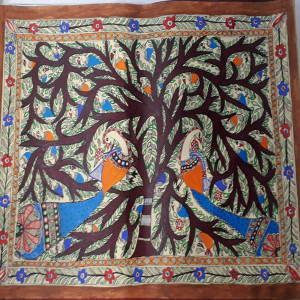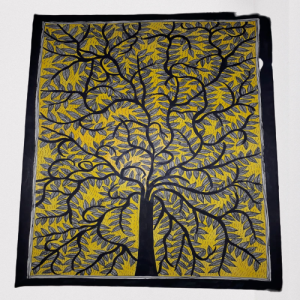BRMP2007
The central figures of the painting would be Radha and Krishna, the divine lovers. Radha might be depicted with her distinctive features, often adorned with traditional clothing and jewelry. Krishna could be portrayed in his iconic form, with a peacock feather in his hair and playing his flute.
- Product Material: Hand paper
- Dimensions:10x10 Inches
- Weight:600 gms
- Usage:Home Decor
Madhubani painting, also known as Mithila painting, is a traditional art form that originated in the Mithila region of Bihar, India. It is a style of folk art that is characterized by its intricate geometric patterns and vibrant colors. Madhubani paintings are created using natural dyes and pigments, and are usually done on handmade paper, cloth or walls.
The history of Madhubani paintings can be traced back to ancient times, and it is believed that women in the Mithila region used to paint the walls of their homes with these intricate designs during auspicious occasions. It was only in the 1960s that these paintings gained recognition as a formal art form, thanks to the efforts of artists like Sita Devi and Ganga Devi.
Madhubani paintings are known for their bold use of color, and the colors used in these paintings have specific meanings. The designs used in Madhubani paintings are usually inspired by nature and Hindu mythology. Common themes include depictions of gods and goddesses, animals, birds, and plants. The paintings often have a symmetrical composition, with the design being repeated on both sides of the central axis.
Madhubani paintings have gained international recognition in recent years, and are now sold and exhibited around the world. They are not just a form of art, but also a source of livelihood for many people in the Mithila region of Bihar.
Madhubani Painting Art earned the Geopgraphical Indication (GI) Tag in 2005.

 INR
INR USD - $
USD - $
 CAD - Can$
CAD - Can$
 EUR - €
EUR - €
 GBP - £
GBP - £
 SGD - S$
SGD - S$
 AUD - A$
AUD - A$
 MYR - (RM)
MYR - (RM)











